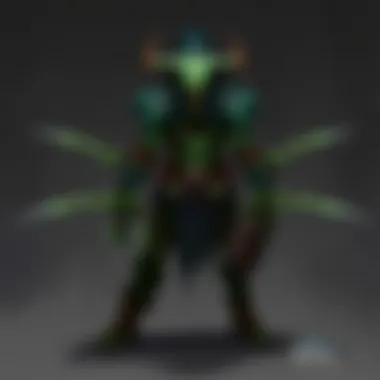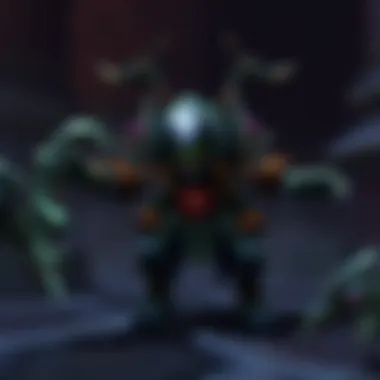Understanding Tomb Stalkers in World of Warcraft


Intro
Tomb Stalkers loom as formidable silhouettes in the haunting landscapes of World of Warcraft. These creatures embody the game's rich tapestry of lore, mechanics, and strategic encounters. To truly appreciate the depth of their existence, one must navigate the intricacies of their nature, including the evolution of their role across expansions, their narrative significance, and their impact on gameplay dynamics.
As players embark on quests through desolate tombs and ancient ruins, they often encounter these spectral hunters, which serve not only as obstacles but as catalysts for deeper engagement within the game. Understanding Tomb Stalkers involves not just recognizing their characteristics, but also grasping the broader implications their existence has on player strategies and the evolving meta.
This exploration provides an avenue for both novice and veteran players to enhance their gaming experience. With a focus on lore, strategic tips, and the nuances of gameplay mechanics, this article endeavors to shine a light on the complexities surrounding Tomb Stalkers, encouraging a deeper appreciation for the shadowy figures that haunt the realms of Azeroth.
Prelims to Tomb Stalkers
In the sprawling universe of World of Warcraft, the Tomb Stalkers emerge as both fascinating creatures and formidable adversaries. Their integration into the game adds layers of complexity, influencing not just gameplay dynamics but also enriching the lore that surrounds the vast world. By diving into this topic, we explore not just what Tomb Stalkers are but also how they weave into the fabric of both player experience and storytelling in the game.
Understanding the essence of Tomb Stalkers isn't merely about knowing they're there; it's about grasping what makes them tick. These creatures encapsulate a certain mystique that captures players' imaginations, serving as a reminder that World of Warcraft is not just a game of numbers and mechanics, but a realm filled with myth and lore.
What are Tomb Stalkers?
Tomb Stalkers are a specific type of creature within the World of Warcraft ecosystem. These menacing beings often lurk in ancient ruins or graveyards, embodying the idea of guardians turned hostile. They are typically depicted as large, skeletal forms, adorned with remnants of the past—pieces of armor and weaponry that hint at their former lives.
Players who encounter Tomb Stalkers will quickly recognize their unique characteristics. For one, these creatures tend to exude a certain eerie aura, which can be unsettling. It is as if they carry the weight of history and the spirits of the long-gone, ready to strike if trespassed upon. Their presence enhances the thrill of exploration, making even the most seasoned adventurers tread carefully.
Moreover, each Tomb Stalker has its specific traits which can vary by region, adding variety and an element of unpredictability to encounters. Their ability to blend into the terrain makes them adept ambushers, further heightening the gaming experience.
The Role of Tomb Stalkers in the Game
The significance of Tomb Stalkers goes beyond just their appearance. They play a crucial role in multiple facets of World of Warcraft. Firstly, they are integrated into various quests and missions, acting as obstacles or challenges that players must overcome. This not only enhances the game's difficulty but also rewards players upon their defeat, often leading to valuable loot or experience points.
Additionally, Tomb Stalkers contribute to the game’s overarching narrative. By featuring in quests that delve into cultural lore and historical context, they act as bridges connecting players to the rich backstories of Azeroth. They embody themes of haunting legacies and the unresolved past, which resonate throughout the game.
The Lore Behind Tomb Stalkers
The lore that surrounds Tomb Stalkers serves as a crucial aspect of understanding their place in the World of Warcraft universe. Far from being mere adversaries to defeat, these creatures embody the rich history and intricate narratives that define the game’s expansive lore. Delving into why these creatures matter will unveil connections to ancient civilizations, historical contexts, and the legends that have been woven into the fabric of Azeroth. Their story reflects themes of loss, resurrection, and the relentless grip of death, which resonates deeply with players navigating the eternal battles within the game.
Historical Context
In a world brimming with countless civilizations, Tomb Stalkers can be traced back to ancient times when mortals dared to tread into realms reserved for the dead. These bleak figures arose from a blend of necromancy and a yearning for vengeance. When an ancient tomb was desecrated, the spirits of the fallen warriors and scholars were stirred from their slumber, reanimated as Tomb Stalkers. This narrative backdrop serves as a reminder to the players about the consequences of their actions.
The lore also emphasizes the connection between the Tomb Stalkers and their creators, the necromancers and power-hungry sorcerers. These dark figures sought to harness the strength of the dead, unleashing forces that would haunt the living. The Tomb Stalkers stand as a testament to the misdeeds of their creators, embodying the wrath of the disturbed dead, forever caught between life and mortality.
Tomb Stalkers in Ancient Civilizations
Tomb Stalkers have found their place in several ancient cultures depicted throughout Azeroth. In Uldum, remnants of the Titans' influence can be seen alongside the Tomb Stalkers. Legends say that the titans crafted artifacts to defend against the undead, inadvertently leading to the rise of these malevolent beings.
Key influences include:
- Nerubians: The ancient race known for their control over underground realms; Tomb Stalkers often clash with their still-living descendants.
- Kvaldir: Ancient seafaring warriors whose spirits, when unable to find peace, emerged as harbingers of chaos akin to the Tomb Stalkers themselves.


In essence, these civilizations not only shape the Tomb Stalkers but also serve as mirrors reflecting the diverging paths of life and death, showcasing how even the most resilient cultures can face the fate of unfinished business.
Myths and Legends Related to Tomb Stalkers
Across the ages, the myths surrounding Tomb Stalkers have sparked tales of terror and cautionary lessons among players. In whispers among adventurers, tales speak of explorers who dared to uncover the tombs only to be hunted down by the wrathful guardians – the Tomb Stalkers.
One prevalent legend speaks of an ancient warrior who, after being betrayed and laid to rest without honor, returned as a Tomb Stalker to avenge his fallen brethren. Many adventurers claim to have encountered variations of this story, each telling the haunting fate of fools who tread recklessly into the confines of the dead. This reinforces the idea that the lore serves not just as background, but as a lesson in respect for the remnants of the past.
"Beware the Tomb Stalkers. They are the echoes of history, rising to remind us what once was and what is eternally lost."
Characteristics of Tomb Stalkers
Understanding the characteristics of Tomb Stalkers enhances players' gameplay and overall connection to the World of Warcraft universe. This analysis goes beyond simple physical attributes; it encompasses behavioral patterns and combat skills as well. Each aspect plays a critical role in how these creatures interact with players and the environment, fostering a deeper appreciation for their place within the game.
Physical Traits
Tomb Stalkers are instantly recognizable due to their distinct physical appearances. These creatures often embody the very essence of their environment, the deserts and ancient ruins of Azeroth. With their skeletal frames covered in remnants of ancient armor, they present a haunting silhouette. Their glowing eyes pierce the darkness, providing an eerie contrast in the desolate landscapes.
The physical structure of Tomb Stalkers offers insight into their lore. Each one bears scars, evidence of past battles, hinting at lengthy histories intertwining with that of the world itself. The spindly legs and elongated limbs lend them a peculiar grace, allowing swift movements over treacherous terrain. This unique build gives an edge in ambushes during encounters, making them formidable foes that often catch players off-guard.
In contrast to their ghostly nature, the Tomb Stalkers display physical resilience, depicted through their ability to absorb damage during engagements. This combination of agility and fortitude requires players to be constantly aware during confrontations.
Behavioral Patterns
When it comes to behavior, Tomb Stalkers exhibit qualities that make them intriguing subjects for study. They are not mere mindless foes; rather, they display a calculated approach to their hunting methods. Utilizing stealth, they often blend seamlessly into their surroundings, waiting patiently for the opportune moment to strike. This behavior suggests a level of intelligence that isn't immediately apparent.
Their nocturnal tendencies further enhance their hunting prowess. Active mostly during the night, these creatures thrive in shadowy environments, utilizing the cover of darkness to their advantage. This plays a significant role in strategy for players, who should adjust their techniques accordingly.
"Understanding the creature's behavior becomes a key strategy for players wishing to succeed against Tomb Stalkers," as noted by various player guides in the community.
Moreover, they often patrol specific areas, establishing territories that they defend vigorously from any intruders. Their restless nature adds an element of unpredictability, urging players to remain vigilant and adaptable to different scenarios.
Abilities and Combat Skills
In the realm of combat, Tomb Stalkers prove to be no pushovers. Their abilities are designed to challenge players at every turn. They wield a range of skills that can disrupt even seasoned players.
One of their key abilities is the Shadow Strike, a swift and lethal attack that can incapacitate anyone caught off-guard. This move is especially dangerous in groups, where the sudden loss of a team member can shift the tide of battle entirely. Additionally, their capability to summon spectral minions adds an extra layer of complexity. This ability creates chaos during encounters, forcing players to divide their attention and resources.
Tomb Stalkers also utilize environmental traps – hidden pitfalls and snares that they can trigger to ensnare unsuspecting adventurers. This knowledge of their surroundings reflects their adaptability in combat.
When preparing for encounters, players should consider equipping gear that enhances mobility and provides crowd-control capabilities. Understanding the abilities of Tomb Stalkers prepares players for the surprise tactics that await them in the wilds of Azeroth.
In summary, the characteristics of Tomb Stalkers go well beyond surface appearances. Their physical traits, behavioral patterns, and combat skills create a complex and engaging challenge for players, enriching the gameplay experience while inviting further exploration of their lore and function within World of Warcraft.
Gameplay Mechanics Involving Tomb Stalkers
In the game of World of Warcraft, mechanics involving Tomb Stalkers are pivotal to shaping a player’s experience and success. Encountering these creatures not only tests a player's skills but also deepens the understanding of the game's combat systems and group dynamics. The mechanics surrounding Tomb Stalkers adds an intricate layer to the gameplay, where strategy and preparation become essential for survival.


Encountering Tomb Stalkers
Encountering Tomb Stalkers can be both a thrilling and daunting experience for players. These creatures are often found lurking in ancient ruins or desolate landscapes, embodying the risks and challenges that come with exploring those areas. For players, spotting one usually means readying themselves for a fierce battle, as Tomb Stalkers are known for their aggressive tactics.
Being aware of the signs—like unsettling silence or flickering shadows—can signal an impending encounter. Knowing the layout of the terrain and being prepared for ambushes represents a crucial aspect.
- Understand Spawn Locations: Each Tomb Stalker has specific spawning areas. Familiarity with these locations aids in planning and preparing for battles.
- Monitor Their Behavior: Tomb Stalkers often exhibit unique patterns, such as retreating slightly before launching a fierce attack. Recognizing these patterns increases a player's chance of survival and, ultimately, success.
Strategies for Defeating Tomb Stalkers
Defeating Tomb Stalkers requires a well-thought-out approach, combining gear, teamwork, and environmental awareness. Players should be prepared to adapt their strategies depending on their unique play style.
Preparation and Gear
When tackling Tomb Stalkers, preparation and gear play a central role that shouldn't be underestimated. Choosing the right equipment not only boosts a character's stats but also provides resilience against the Tomb Stalker’s high damage output.
- Key Characteristic: Prioritizing gear that enhances survivability is crucial. Shields with high durability or armor with bonus stats can significantly extend a player's longevity in tough fights.
- Unique Features: Various gear pieces provide special effects, such as increased healing or damage absorption. These attributes can be game-changers in encounters, making it imperative to equip strategically.
- Advantages and Disadvantages: While heavy armor might provide substantial protection, it can slow movement. Conversely, lighter gear may allow for agility but at the cost of defense. Balancing these factors is essential for a successful outcome.
Group Dynamics
The power of group dynamics should never be overlooked in any encounter with Tomb Stalkers. Working as a cohesive unit allows players to combine their strengths and cover weaknesses, creating a strong front against these formidable foes.
- Key Characteristic: Team roles play a significant part; having a good tank, DPS, and support healer can dramatically increase the probability of success.
- Unique Features: Players need to communicate effectively and coordinate their attacks. Relying on each other's skills, like stuns or crowd control, can help manage the chaos during intense battles.
- Advantages and Disadvantages: A well-oiled group works like a finely tuned machine, dealing with threats efficiently. However, disorganization can lead to quick downfalls, highlighting the importance of coordination.
Environment Utilization
In the heat of battle with Tomb Stalkers, environment utilization can be a subtle but effective strategy. Being aware of the surroundings affords players numerous tactical advantages during encounters.
- Key Characteristic: Terrain can be harnessed to create obstructions, allowing players to dodge attacks or take cover.
- Unique Features: Certain areas might have natural traps or features that players can exploit. For instance, leading enemies into tight spots may limit their movement and accessibility.
- Advantages and Disadvantages: While manipulating the environment can provide a tactical edge, players must also be cautious of potential dangers it may pose to themselves. Environmental hazards could lead to traps or smart NPCs that cause harm to players instead.
Loot and Rewards
Defeating Tomb Stalkers often comes with substantial rewards, making the risk worth the effort. The potential loot drops can be game enhancers for further adventures, showcasing the balance of dangers and incentives prevalent in World of Warcraft.
Success against Tomb Stalkers not only plays into the thrill of gameplay but enriches the player's overall experience by providing valuable rewards and enhancing their character's skills and abilities.
Evolution Throughout Expansions
The evolution of tomb stalkers spans numerous expansions in World of Warcraft, revealing how developers have transformed these haunting creatures to keep pace with the game’s ever-expanding universe. The adjustments in their design and mechanics not only reflect the technical advancements but also the shifting focus on player engagement and storyline development. This progression is significant; it helps to maintain player interest while also reflecting broader trends in game design and player expectations. Let's take a closer look at the tomb stalkers across various phases of the game.
Tomb Stalkers in Classic WoW
When players first encountered tomb stalkers in Classic WoW, they embodied a sense of mystery and fear. These creatures were primarily found in locations such as the deserts of Tanaris and the eerie tombs of Silithus, often lurking in the shadows, waiting to pounce on unsuspecting adventurers. Their initial role was that of a minor adversary, providing a sense of challenge, yet they were not overly complex in terms of combat mechanics.
In those early days, their attacks were straightforward. A swift ambush could easily fell a low-level player who ventured too close, which added to the tension of exploring their territories. Moreover, the lore surrounding them, although simple compared to later expansions, laid the groundwork for their continued presence in the game. Players often exchanged tales about encounters with these stalkers, forging a shared experience within the community.


Changes in Recent Expansions
As expansions rolled on, tomb stalkers morphed significantly, adapting to the demands of contemporary gameplay. With the arrival of expansions like Legion and Battle for Azeroth, the complexity and depth of these creatures have expanded dramatically. New combat mechanics and abilities were introduced, which elevated their role from mere background threats to formidable opponents requiring team strategies for defeat.
For instance, in Legion, players noticed that tomb stalkers developed enhanced agility and new skills that challenged conventional gameplay approaches. They became woven into larger narratives, contributing to significant quests and encounters. The addition of unique loot dropped by these creatures further incentivized players to pursue them, creating a dynamic where tomb stalkers became an essential part of the game economy. The community reaction to these changes was generally positive, welcoming the deeper immersion and the expanded lore surrounding these creatures.
Future Predictions and Speculations
Looking ahead, the potential for tomb stalkers to evolve further is intriguing. Given Blizzard's history of refreshing creature design and mechanics, players can expect to see enhanced AI capabilities, making encounters with tomb stalkers more unpredictable. The developers might integrate more interactive elements, perhaps incorporating environmental effects that require players to adapt their strategies in real-time.
Moreover, as narratives continue to intertwine within the game, tomb stalkers may find themselves intricately linked to new story arcs, perhaps even acting as protectors of ancient secrets or artifacts. The community often speculates on what will come next, and engaging in these discussions offers insight into the player base’s hopes.
"The evolution of tomb stalkers reflects not just changes in the game, but also the way players engage with the world of Warcraft. It’s a dance between lore and gameplay that keeps players coming back for more."
With each new expansion, tomb stalkers continue to stand as a testament to the game's longevity and adaptability, symbolizing how a creature can evolve from a simple foe into a pivotal figure in the ongoing saga of World of Warcraft.
Cultural Influence and Community Reception
The presence of Tomb Stalkers in World of Warcraft goes beyond their formidable characteristics and gameplay mechanics. These creatures have permeated the fabric of the game's community and culture, having left a lasting mark on how players engage with the game and with each other. Understanding the cultural influence of Tomb Stalkers shines a light on the ways in which they inspire creativity, build camaraderie, and form unique discussions among the player base.
Tomb Stalkers in World of Warcraft Fan Culture
Tomb Stalkers represent not just monsters to conquer; they have become icons within the World of Warcraft (WoW) community. Players often connect with these beings on various levels, exploring their lore and significance in discussions across platforms like Reddit or fan forums. Players frequently share their experiences and strategies, bonding over stories of close calls in boss fights or triumphs after defeating these challenging foes.
- Community Encounters: Fans routinely recount their personal encounters with Tomb Stalkers, adding layers to the creature’s mythos. Often, these stories are embellished with details that add a personal flair, reinforcing the sense of community.
- Cultural References: Within player circles, players make references to Tomb Stalkers in memes, jokes, and even in-game guild names. Such aspects enhance the playful nature surrounding these creatures, fostering a strong sense of belonging among players who share a common interest.
- Narrative Discussions: Conversations on platforms like Reddit take a deeper dive into Tomb Stalkers' lore, analyzing their origins and role in the game’s story. Such discussions perpetuate a sense of depth to the narratives intertwined with gameplay experiences.
Fan Art and Community Creations
The artistic expressions stemming from the Tomb Stalkers' concept further illuminate their cultural impact. Players have created intricate fan art, showcasing their interpretations of these creatures. The artwork represents a blend of skills and styles, with everything from realistic portrayals to whimsical interpretations that capture their essence in unique ways.
- Gallery Displays: Online platforms like DeviantArt and Tumblr have numerous galleries dedicated to fan creations. Here, players not only showcase their art but also provide critiques and encouragement, creating a supportive milieu.
- In-Game Fan Tributes: Beyond traditional art, players often honor Tomb Stalkers by creating themed guilds or events where members dress up their characters to represent these creatures. These events develop a communal atmosphere where players come together, celebrating their shared interests.
- Collaborative Projects: The community doesn't stop at individual creations. Groups often collaborate to produce larger projects, like animations or comic strips. These shared endeavors strengthen interpersonal connections and highlight the creativity inspired by Tomb Stalkers.
"Art is the most beautiful of all lies; it transforms the frightening into something we can all appreciate. Fighting Tomb Stalkers isn’t just about battles; it’s about forging art through shared experiences."
In wrapping all this together, Tomb Stalkers stand as a testament to the strong cultural and social networks that form around the World of Warcraft universe. They are more than mere adversaries; they are part of a rich tapestry of storytelling, interaction, and creativity—elements that engage the players far beyond the mechanics of the game itself.
Culmination
The enduring presence of Tomb Stalkers in World of Warcraft encapsulates not just a unique aspect of gameplay but also a deep cultural resonance within the gaming community. Their intricate design, lore, and the challenges they present make them a focal point of engagement for players. Understanding why they matter extends beyond just encounters or loot; it taps into the narrative fabric of the game itself.
Summary of Key Points
Throughout this article, we have explored several facets that illuminate the significance of Tomb Stalkers:
- Historical Context: Their connections to ancient civilizations add depth and intrigue to the World of Warcraft narrative.
- Characteristics: Their distinctive traits and combat abilities pose unique challenges that can test the mettle of even seasoned players.
- Gameplay Mechanics: Understanding how to encounter and successfully defeat Tomb Stalkers enhances player experience and knowledge of tactical strategies.
- Cultural Reception: The way Tomb Stalkers have been embraced by the fanbase showcases their impact on the game's community, inspiring everything from fan art to theories.
By synthesizing these elements, we appreciate the Tomb Stalkers not just as mere enemies, but as essential components that enrich the World of Warcraft experience.
Final Thoughts on Tomb Stalkers
In wrapping up our discussion, it’s crucial to reflect on the broader implications of Tomb Stalkers in World of Warcraft. They serve as a reminder that each creature within the game is imbued with purpose - be it to challenge players, present narrative depth, or add flair to the richly woven tapestry of lore.
Encounters with Tomb Stalkers can be frustrating at times, but they also offer a sense of achievement upon victory. As players adapt and adopt strategies learned through trial and error, they not only grow individually but contribute to the collective knowledge shared within the community. The discussions on forums like Reddit or fan pages on Facebook exemplify this shared journey of learning and discovery.







